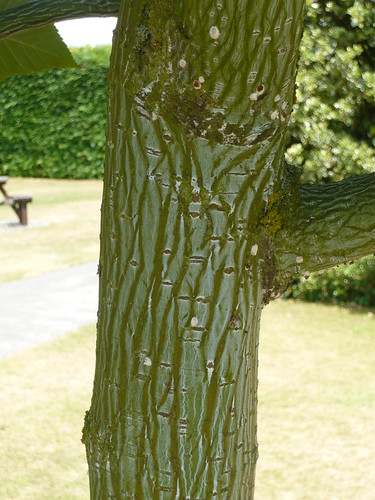Snake Bark Maple – Acer Varieties
Acer rufinerve is the tree I have always believed to be the Snake Bark Maple shown above. It has red autumn leaves and the distinctive bark. However there are other Maples with a snake bark and they tend to cross pollinate.
Acer grosseri var. hersii
- A popular snakebark maple for small gardens, since it grows rapidly in its early years and then settles down.
- Can be pruned in winter to control final size.
- An established tree is unmistakable with its upright branches with green bark striped conspicuously with white.
- The seeds in pairs of broad wings are clustered on long strings.
- In autumn the thick, rubbery leaves turn yellow, orange and red shades.
Acer capillipes
- The background colours may be green, dark purplish-brown or red overlayed by a vertical lattice of fine white lines giving a snake skin effect.
- This species, when young, is one of the finest for bark colour.
- After 2 years the bark becomes browner and then greenish-brown with well defined white vertical stripes.
- The tree has bright green, three lobed leaves which turn orange and red in the autumn.
- Hybrids with other closely related ‘snake-barks’ are common.
- The name capillipes is a reference to the slender hair like stalks on the seeds.
Acer davidii ‘George Forrest’
- A tree with spreading branches with a pendulous habit reaching 24-30′
- The leaves are dark green, triangular, glossy and deeply-veined and are held on bright red stalks that catch the light.
- A snake bark maples noted for its smooth, striped bark in shades of green, brown and silvery white.
- The spring flowers are yellow held on pendulous stalks.
- This maple needs a sheltered site or the foliage can get scorched.
- Site the tree near a path so the beauty of its bark can be admired.
Acer pensylvanicum – ‘Erythrocladum’
- Forms a rounded compact tree suitable for small gardens
- Will not tolerate exposed or hot and sunny locations.
- Red stems and trunk dominate the grey stripes
Follow the full story of Bark on our other pages
